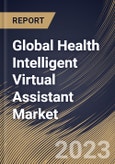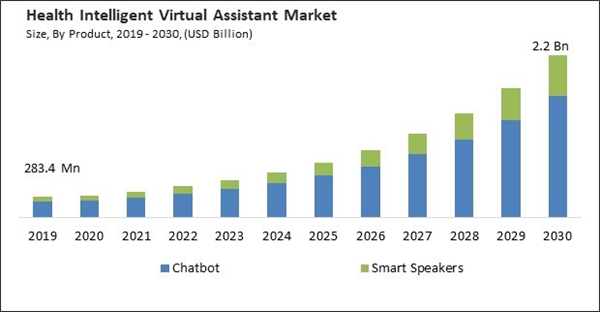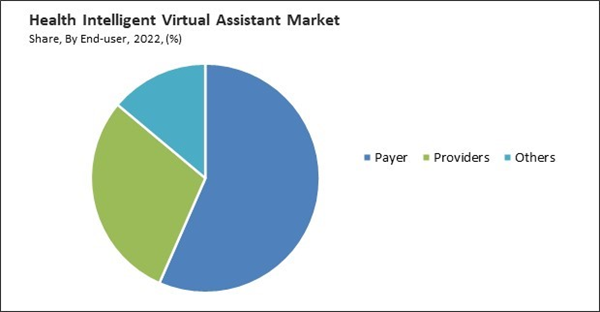The Global Health Intelligent Virtual Assistant Market size is expected to reach $2.2 billion by 2030, rising at a market growth of 23.3% CAGR during the forecast period.
Health virtual assistants provide patients with information, schedule appointments, and answer basic healthcare-related queries, improving patient satisfaction. Therefore, the provider segment would capture around 30% share in the market by 2030. As healthcare providers experience the tangible benefits of IVAs in enhanced efficiency and productivity, they are more likely to adopt these systems. The more organizations that embrace IVAs, the larger the market becomes. By automating routine administrative tasks, healthcare staff can dedicate more time and attention to complex patient care, diagnostics, and treatment. This results in improved patient outcomes and experiences, making IVAs a valuable tool for healthcare facilities. Some of the factors impacting the market are increasing adoption of IVAs due to higher cost of healthcare services, growing adoption of wearable devices and privacy and security concerns associated with the adoption of health IVAs.
IVAs help healthcare organizations reduce costs by automating administrative tasks like appointment scheduling, billing inquiries, and insurance verification. By doing so, healthcare facilities can allocate their human resources more efficiently and avoid the expenses associated with human staff for routine administrative work. Health IVAs streamline administrative processes and data management, improving operational efficiency. Health IVAs enhance the patient experience by providing prompt responses, offering personalized information, and assisting with remote monitoring. These factors will propel the future demand for health intelligent virtual assistants. Furthermore, wearables, such as fitness trackers and smartwatches, have become instrumental in transforming the healthcare landscape. These devices collect a wealth of health data, including heart rate, sleep patterns, physical activity, and more. Moreover, the adoption of wearable devices augments the personalization of healthcare. Health virtual assistants can tailor their recommendations and support based on the data received from wearables. For instance, if a user's wearable records a decrease in physical activity, the virtual assistant can suggest exercise routines or send reminders to stay active. Thus, these factors are expected to propel the expansion of the market.
Additionally, with the need for social distancing and the risk of in-person visits, the demand for telehealth services skyrocketed during the pandemic. Health IVAs were crucial in enabling remote consultations, facilitating appointments, and addressing patient queries. This surge in telehealth services led to a heightened demand for IVAs as an integral part of telehealth platformsHealth IVAs assisted in managing increased appointment bookings, billing inquiries, and insurance-related tasks, freeing up administrative staff to focus on other critical responsibilities. Therefore, the COVID-19 pandemic accelerated the adoption of telehealth, enhanced the role of AI-powered healthcare assistants, and pushed the boundaries of innovation in the field.
However, Healthcare data regulations, such as HIPAA in the United States, impose strict requirements for the protection and confidentiality of patient data. Ensuring compliance with these regulations is a complex and resource-intensive process. For smaller or more recent IVA developers, the difficulty and expense of maintaining regulatory compliance may be a barrier to entrance. This can limit competition in the market, potentially leading to reduced innovation and higher costs for healthcare organizations seeking IVA solutions.Furthermore, patients and healthcare professionals must trust that IVAs will handle their data securely and comply with regulations. Concerns about data breaches or privacy violations can erode this trust, leading to reluctance to use or adopt IVAs. All these factors are expected to hamper the growth of the market in the upcoming years.
The market research report covers the analysis of key stake holders of the market. Key companies profiled in the report include eGain Corporation, Microsoft Corporation, MedRespond, Next IT Solutions Inc., True Image Interactive, Inc., Virgin Pulse, Inc., Verint Systems, Inc., Babylon Holdings Limited, Amazon.com, Inc., and Sensely, Inc.
Health virtual assistants provide patients with information, schedule appointments, and answer basic healthcare-related queries, improving patient satisfaction. Therefore, the provider segment would capture around 30% share in the market by 2030. As healthcare providers experience the tangible benefits of IVAs in enhanced efficiency and productivity, they are more likely to adopt these systems. The more organizations that embrace IVAs, the larger the market becomes. By automating routine administrative tasks, healthcare staff can dedicate more time and attention to complex patient care, diagnostics, and treatment. This results in improved patient outcomes and experiences, making IVAs a valuable tool for healthcare facilities. Some of the factors impacting the market are increasing adoption of IVAs due to higher cost of healthcare services, growing adoption of wearable devices and privacy and security concerns associated with the adoption of health IVAs.
IVAs help healthcare organizations reduce costs by automating administrative tasks like appointment scheduling, billing inquiries, and insurance verification. By doing so, healthcare facilities can allocate their human resources more efficiently and avoid the expenses associated with human staff for routine administrative work. Health IVAs streamline administrative processes and data management, improving operational efficiency. Health IVAs enhance the patient experience by providing prompt responses, offering personalized information, and assisting with remote monitoring. These factors will propel the future demand for health intelligent virtual assistants. Furthermore, wearables, such as fitness trackers and smartwatches, have become instrumental in transforming the healthcare landscape. These devices collect a wealth of health data, including heart rate, sleep patterns, physical activity, and more. Moreover, the adoption of wearable devices augments the personalization of healthcare. Health virtual assistants can tailor their recommendations and support based on the data received from wearables. For instance, if a user's wearable records a decrease in physical activity, the virtual assistant can suggest exercise routines or send reminders to stay active. Thus, these factors are expected to propel the expansion of the market.
Additionally, with the need for social distancing and the risk of in-person visits, the demand for telehealth services skyrocketed during the pandemic. Health IVAs were crucial in enabling remote consultations, facilitating appointments, and addressing patient queries. This surge in telehealth services led to a heightened demand for IVAs as an integral part of telehealth platformsHealth IVAs assisted in managing increased appointment bookings, billing inquiries, and insurance-related tasks, freeing up administrative staff to focus on other critical responsibilities. Therefore, the COVID-19 pandemic accelerated the adoption of telehealth, enhanced the role of AI-powered healthcare assistants, and pushed the boundaries of innovation in the field.
However, Healthcare data regulations, such as HIPAA in the United States, impose strict requirements for the protection and confidentiality of patient data. Ensuring compliance with these regulations is a complex and resource-intensive process. For smaller or more recent IVA developers, the difficulty and expense of maintaining regulatory compliance may be a barrier to entrance. This can limit competition in the market, potentially leading to reduced innovation and higher costs for healthcare organizations seeking IVA solutions.Furthermore, patients and healthcare professionals must trust that IVAs will handle their data securely and comply with regulations. Concerns about data breaches or privacy violations can erode this trust, leading to reluctance to use or adopt IVAs. All these factors are expected to hamper the growth of the market in the upcoming years.
End-user Outlook
Based on end-user, the market is segmented into payer, providers, and others. In 2022, the payer segment held the largest a significant revenue share in the market. Healthcare payers like insurance companies and government agencies handle many administrative tasks, including claims processing, member management, and billing. Intelligent virtual assistants can streamline these processes, reducing administrative costs and improving overall efficiency. Healthcare payers are under constant pressure to control costs.Product Outlook
Based on product, the market is bifurcated into chatbot and smart speakers. The chatbot segment held the largest revenue share in the market in 2022. Chatbots can provide round-the-clock support to patients and answer their queries, which is particularly valuable in healthcare, where people may have questions or concerns at any time. Chatbots can engage with patients, remind them of appointments, provide medication reminders, and offer support for managing chronic conditions. These factors are expected to boost the demand in the segment.Technology Outlook
On the basis of technology, the market is divided automatic speech recognition, text to speech, and text based. In 2022, the automatic speech segment witnessed a substantial revenue share in the market. The rise in demand for automatic speech recognition (ASR) technology in the market can be attributed to several factors. ASR technology allows users to interact with virtual assistants through natural speech, making the user experience more intuitive and user-friendly.Regional Outlook
By region, the market is segmented into North America, Europe, Asia Pacific, and LAMEA. The North America segment procured the highest revenue share in the market in 2022. The healthcare industry in North America has been actively embracing technology, including health intelligent virtual assistants, to streamline operations, enhance patient care, and improve overall efficiency. The healthcare industry in North America is heavily regulated, and policies often drive the adoption of new technologies. Regulatory bodies have supported digital health solutions, including intelligent virtual assistants, encouraging their growth. As a result, in the future, there will be more demand in the North America segment.The market research report covers the analysis of key stake holders of the market. Key companies profiled in the report include eGain Corporation, Microsoft Corporation, MedRespond, Next IT Solutions Inc., True Image Interactive, Inc., Virgin Pulse, Inc., Verint Systems, Inc., Babylon Holdings Limited, Amazon.com, Inc., and Sensely, Inc.
Strategies deployed in the Market
- Aug-2023: Virgin Pulse, Inc. formed a partnership with Cigna Group, an American multinational healthcare and insurance company. Through this partnership, myCigna was launched. myCigna is an AI-powered platform that assists customers to track daily metrics, set personal health goals, and receive feedback and necessary guidance based on their performance.
- Jul-2023: Amazon Web Services, Inc., a subsidiary of Amazon.com, released AWS HealthScribe, a HIPAA-eligible service. AWS HealthScribe helps save time for physicians by using generative AI and speech recognition and generating clinical notes. The new product uses a single API to find out key details, creating transcripts and summaries that are ready to be inserted into an electronic health record (EHR) system.
- May-2023: Microsoft Corporation collaborated with Builder.ai, an AI-powered next-generation composable software development platform. Through this collaboration, the two companies developed AI-powered solutions that allow businesses to develop applications and become digitally native without the need for technical knowledge.
- Apr-2023: Microsoft Corporation expanded its collaboration with Epic Games, Inc., an American video game and software developer. Through this collaboration, the Azure OpenAI Service was combined with Epic’s industry-leading electronic health record (EHR) software to incorporate generative AI into healthcare. Additionally, the collaboration enhanced productivity, patient care, and the global healthcare system.
- Apr-2023: Amazon Web Services, Inc., a subsidiary of Amazon.com, teamed up with 3M Health Information Systems (HIS), a company offering health information management software. Through this collaboration, 3M applied machine learning (ML) and generative AI services from AWS to strengthen its virtual assistant solutions and clinical documentation.
- Mar-2023: Nuance Communications, Inc., a subsidiary of Microsoft Corporation, launched Dragon Ambient Experience (DAX) Express, an application powered by artificial intelligence that is used by healthcare workers for taking notes. DAX Express decreases the administrative burden of healthcare workers by regenerating a draft of their clinical notes automatically and immediately after the visit of the patient. Additionally, the incorporation of ambient AI into the new product helps in getting insights from unstructured data.
- Jan-2023: Microsoft Corporation partnered with OpenAI, the company that developed ChatGPT. Through this partnership, Microsoft enhanced its AI innovations.
- Oct-2022: Microsoft Corporation collaborated with Haleon plc, a British multinational consumer healthcare company. Through this collaboration, the Microsoft Seeing AI app was introduced. The new product makes it easier for people with blindness and low literacy to read product labels by providing detailed labeling information.
- Apr-2022: Sensely, Inc. partnered with Keralty S.A.S., a multinational health organization, and Sanitas USA, Inc., a leading primary healthcare provider. Through this partnership, the white-labelled technology of Sensely was combined with the mySanitas app of Sanitas.
- Mar-2022: Sensely, Inc. unveiled NextStep, a management engine that serves the needs of both payers and providers. NextStep offers the organizations the opportunity to link the outcomes with a list of suitable venues that meet the requirements of the enterprise.
- Oct-2021: Babylon Holdings Limited collaborated with Microsoft Corporation, a leading developer of personal-computer software systems and applications. Through this collaboration, Babylon utilized the AI and machine learning technologies of Microsoft to induce preventative healthcare. Additionally, the collaboration improved patient outcomes, consumer experiences, and decreased costs.
- Jun-2021: Babylon Holdings Limited formed a merger with Alkuri Global Acquisition Corp., a special-purpose acquisition company. Through this merger, Babylon improved the services it extended to both its existing and new customers.
- Oct-2019: Microsoft Corporation partnered with Humana, Inc., an American health insurance company. Through this partnership, Azure AI and Microsoft 365 were amalgamated with FHIR to develop intelligent automation and predictive solutions to improve the care extended to its members. Additionally, care teams were provided with real-time access to information through a cloud platform.
Scope of the Study
Market Segments Covered in the Report:
By Product- Chatbot
- Smart Speakers
- Text to Speech
- Text Based
- Automatic Speech Recognition
- Payer
- Providers
- Others
- North America
- US
- Canada
- Mexico
- Rest of North America- Europe
- Germany
- UK
- France
- Russia
- Spain
- Italy
- Rest of Europe- Asia Pacific
- China
- Japan
- India
- South Korea
- Singapore
- Malaysia
- Rest of Asia Pacific- LAMEA
- Brazil
- Argentina
- UAE
- Saudi Arabia
- South Africa
- Nigeria
- Rest of LAMEA
Key Market Players
List of Companies Profiled in the Report:
- eGain Corporation
- Microsoft Corporation
- MedRespond
- Next IT Solutions Inc.
- True Image Interactive, Inc.
- Virgin Pulse, Inc.
- Verint Systems, Inc.
- Babylon Holdings Limited
- Amazon.com, Inc.
- Sensely, Inc.
Unique Offerings
- Exhaustive coverage
- The highest number of Market tables and figures
- Subscription-based model available
- Guaranteed best price
- Assured post sales research support with 10% customization free
Table of Contents
Chapter 1. Market Scope & Methodology
Chapter 2. Market at a Glance
Chapter 3. Market Overview
Chapter 5. Global Health Intelligent Virtual Assistant Market by Product
Chapter 6. Global Health Intelligent Virtual Assistant Market by Technology
Chapter 7. Global Health Intelligent Virtual Assistant Market by End-user
Chapter 8. Global Health Intelligent Virtual Assistant Market by Region
Chapter 9. Company Profiles
Companies Mentioned
- eGain Corporation
- Microsoft Corporation
- MedRespond
- Next IT Solutions Inc.
- True Image Interactive, Inc.
- Virgin Pulse, Inc.
- Verint Systems, Inc.
- Babylon Holdings Limited
- Amazon.com, Inc.
- Sensely, Inc.
Methodology

LOADING...










